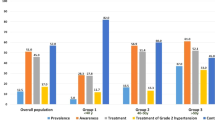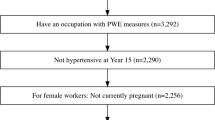Abstract
In order to establish the methodology of a population strategy for improving cardiovascular risk factors, we have planned the High-risk and Population Strategy for Occupational Health Promotion Study (HIPOP-OHP study). This study is a nonrandomized control trial in approximately 6500 participants in six intervention and six control companies. Our population strategy is based on three factors, nutrition, physical activity, and smoking. For each factor, a researcher's working team was organized and has been supporting the intervention. A standardized method to obtain comparable data has also been established. In the baseline survey, urinary sodium excretion in male subjects was higher, and urinary potassium excretion was lower in both genders in the intervention group compared to the control group. The prevalence of hypertension for both genders was also higher in the intervention group. Male subjects in the intervention group had higher serum total cholesterol than controls, while high-density lipoprotein cholesterol was lower in both genders in the intervention group compared to the control group. These differences were reflected by our finding that the predicted relative risk of coronary heart disease for male subjects was significantly higher in the intervention group (relative risk, RR: 1.17; 95% confidence interval, 95% CI.: 1.09, 1.25) and significantly lower in the control group (RR: 0.93; 95% CI.: 0.89, 0.98) compared to a model Japanese population. Similar results were observed in the female subjects. Taken together, these findings indicate that it is possible to compare trends of predicted relative risk for coronary heart disease between two groups.
This is a preview of subscription content, access via your institution
Access options
Subscribe to this journal
Receive 12 digital issues and online access to articles
$119.00 per year
only $9.92 per issue
Buy this article
- Purchase on Springer Link
- Instant access to full article PDF
Prices may be subject to local taxes which are calculated during checkout
Similar content being viewed by others
References
Ueshima H et al. Effect of reduced alcohol consumption on blood pressure in untreated hypertensive men. Hypertension 1993; 21: 248–252.
Iso H et al. One-year community-based education program for hypercholesterolemia in middle-aged Japanese: a long-term outcome at 8-year follow-up. Atherosclerosis 2002; 164: 195–202.
Fukahori M et al. Program of Exercise Training as Total Health Promotion Plan and its Evaluation. J Occup Health 1999; 41: 76–82.
Iso H et al. Community-based education classes for hypertension control. A 1.5-year randomized controlled trial. Hypertension 1996; 27: 968–974.
Fisher KJ, Glasgow RE, Terborg JR . Worksite smoking cessation: a meta-analysis of long-term quit rates from controlled studies. J Occup Med 1990; 32: 429–439.
Fielding JE et al. Evaluation of the IMPACT blood pressure program. J Occup Med 1994; 36: 743–746.
Glanz K, Sorensen G, Farmer A . The health impact of worksite nutrition and cholesterol intervention program. Am J Health Promot 1996; 10: 453–470.
Kadowaki T et al. Effectiveness of smoking-cessation intervention in all of the smokers at a worksite in Japan. Ind Health 2000; 38: 396–403.
Muto T, Yamauchi K . Evaluation of a multicomponent workplace health promotion program conducted in Japan for improving employees' cardiovascular disease risk factors. Prev Med 2001; 33: 571–577.
Heaney C, Goetzel RZ . A review of multi-component worksite health promotion programs. Am J Health Promot 1997; 11: 290–308.
Rose G . The Strategy of Preventive Medicine. Oxford University Press: Oxford, 1992.
Rose G . Sick individuals and sick populations. Int J Epidemiol 2001; 30: 427–432 (reiteration).
Stamler J et al. INTERSALT study findings. Public health and medical care implications. Hypertension 1989; 14: 570–577.
Kottke TE et al. Preventing heart disease: is treating the high risk sufficient? J Clin Epidemiol 1988; 41: 1083–1093.
Cook NR et al. Implications of small reductions in DBP for primary prevention. Arch Intern Med 1995; 155: 701–709.
Rogers A, Lawes C, MacMahon S . Reducing the global burden of blood pressure related cardiovascular disease. J Hypertens 2000; 18 (Suppl 1): S3–S6.
Scheuermann W et al. Effectiveness of a decentralized, community-related approach to reduce cardiovascular disease risk factor levels in Germany. Eur Heart J 2000; 21: 1591–1597.
Steyn K et al. Twelve-year results of the Coronary Risk Factor Study (CORIS). Int J Epidemiol 1997; 26: 964–971.
Luepker RV et al. Community education for cardiovascular disease prevention. Morbidity and mortality results from the Minnesota Heart Health Program. Am J Epidemiol 1996; 144: 351–362.
Fortmann SP, Varady AN . Effects of a community-wide health education program on cardiovascular disease morbidity and mortality: the Stanford Five-City Project. Am J Epidemiol 2000; 152: 316–323.
Vartiainen E et al. Cardiovascular risk factor changes in Finland, 1972–1997. Int J Epidemiol 2000; 29: 49–56.
Korhonen T et al. Impact of mass media and interpersonal health communication on smoking cessation attempts: a study in North Karelia, 1989–1996. J Health Commun 1998; 3: 105–118.
Iso H et al. Effects of a long-term hypertension control program on stroke incidence and prevalence in a rural community in north-eastern Japan. Stroke 1998; 29: 1510–1518.
World Health Organisation European Collaborative Group. European collaborative trial of multifactorial prevention of coronary heart disease: final report on the 6-year results. Lancet 1986; 1 (8486): 869–872.
Okamura T et al. Specific alcoholic beverage and blood pressure in a middle-aged Japanese population: the high-risk and population strategy for occupational health promotion (HIPOP-OHP) study. J Hum Hypertens. 2004; 18: 9–16.
Ueshima H The report of the Intervention study for cardiovascular high risk population through lifestyle modification Heath Sciences Research Grants, Ministry of Health and Welfare, Tokyo, 1998 (in Japanese).
Tanaka T et al. A simple method to estimate populational 24-h urinary sodium and potassium excretion using a casual urine specimen. J Hum Hypertens 2002; 16: 97–103.
Ueshima H et al. Differences in cardiovascular disease risk factors between Japanese in Japan and Japanese-Americans in Hawaii: the INTERLIPID study. J Hum Hypertens 2003; 17: 631–639.
Nakamura M, Sato S, Shimamoto T . Improvement in Japanese clinical laboratory measurements of total cholesterol and HDL-cholesterol by the US cholesterol reference method laboratory network. J Atheroscler Thromb 2003; 10: 145–153.
D'Agostino Sr RB et al. Validation of the Framingham coronary heart disease prediction scores: results of a multiple ethnic groups investigation. JAMA 2001; 286: 180–187.
Kitamura A et al. High-density lipoprotein cholesterol and premature coronary heart disease in urban Japanese men. Circulation 1994; 89: 2533–2539.
Okamura T, Naito Y, Iida M . Obesity and Hypertension. Circ Sci 1998; 18: 674–677 (in Japanese).
National Survey on Circulatory Disorders 2000. Summary on June 2001 (in Japanese), Ministry of Health, Labor and Welfare, Tokyo, 2001.
Tsubono Y, Hisamichi S . Screening for gastric cancer in Japan. Gastric Cancer 2000; 3 (4): 9–18.
Hisamichi S . Community screening programs of cancer and cardiovascular diseases in Japan. J Epidemiol 1996; 6: S159–S163.
Iso H et al. Changes in 24-hour urinary excretion of sodium and potassium in a community-based heath education program on salt reduction. Nippon Koshu Eisei Zasshi 1999; 46: 894–903 (in Japanese).
Rose G, Heller RF, Pedoe HT, Christie DG . Heart disease prevention project: a randomised controlled trial in industry. BMJ 1980; 280 (6216): 747–751.
Crawford D . Population strategies to prevent obesity. Only few studies attempted so far and with limited success. BMJ 2002; 325: 728–729.
Stamler J . The INTERSALT Study: background, methods, findings, and implications. Am J Clin Nutr 1997; 65 (2 Suppl): 626S–642S.
Ueshima H, Zhang XH, Choudhury SR . Epidemiology of hypertension in China and Japan. J Hum Hypertens 2000; 14: 765–769.
Grufferman S . Complexity and the Hawthorne effect in community trials. Epidemiology 1999; 10: 209–210.
Acknowledgements
This study was funded by research grants from the Ministry of Health and Welfare, Japan (H10-12, No. 063, Research on Health Services, Health Sciences Research Grants, H13, No. 010 Medical Frontier Strategy Research, Health Sciences Research Grants) and from the Ministry of Health, Labor and Welfare, Japan (H14, No. 010 Clinical Research for Evidenced Based Medicine, Health and Labor Sciences Research Grants). We thank Toshimi Yoshida, Department of Health Science, Shiga University of Medical Science, for her excellent clerical support in this research.
Author information
Authors and Affiliations
Consortia
Corresponding author
Appendix
Appendix
HIPOP-OHP Research group:
Chairman: Hirotsugu Ueshima (Department of Health Science, Shiga University of Medical Science, Otsu, Shiga).
Participating Researchers: Akira Okayama, Nobuo Nishi, Keiko Tsuji (Department of Hygiene and Public Health, Iwate Medical University, School of Medicine, Iwate), Katsushi Yoshita (Department of National Nutrition Survey and Health Informatics, National Institute of Health and Nutrition), Toru Takebayashi, Yuriko Kikuchi (Department of Preventive Medicine and Public Health, School of Medicine, Keio University), Hideaki Nakagawa, Katsuyuki Miura (Department of Public Health, Kanazawa Medical University), Hiroshi Yamato (Institute of Industrial Ecological Science, University of Occupational and Environmental Health), Nagako Chiba (Department of Human-Life, Tsukuba International Junior College), Masahiko Yanagita (Department of Health and Nutrition, Yonezawa Women's College of Yamagata Prefecture), Kazunori Kodama, Fumiyoshi Kasagi (Department of Epidemiology, Radiation Effects Research Foundation), Yukinori Kusaka (Department of Environmental Health, School of Fukui Medical University), Shigeyuki Saitoh (Second Department of Internal Medicine School of Medicine, Sapporo Medical University), Kiyomi Sakata (Department of Public Health, Wakayama Medical University), Hideo Tanaka (Department of Cancer Control and Statistics, Osaka Medical Center for Cancer and Cardiovascular Diseases), Masakazu Nakamura (Cholesterol Reference Laboratory Network at Osaka Medical Center for Health Science and Promotion), Masakazu Nakamura, Yoshihiko Naito (Osaka Medical Center for Health Science and Promotion), Yasuyuki Nakamura (Division of Cardiology, Department of Medicine, Shiga University of Medical Science), Makoto Watanabe, Yoshikazu Nakamura (Department of Public Health, Jichi Medical School), Akira Babazono (Institute of Health Science, Kyushu University), Unai Tamura, Junko Minai, Zentaro Yamagata (Department of Health Sciences, School of Medicine, University of Yamanashi), Sumio Urano (Matsushita Health Care Center), Fujihisa Kinoshita (Wakayama Wellness Foundation), Isao Saitoh (Department of Public Health, Nara Medical University), Shinichi Tanihara (Department of Environmental Medicine, Shimane Medical University), Junko Tamaki (Department of Public Health, Hokkaido University Graduate School of Medicine), Osamu Tochikubo (Department of Public Health, Yokohama City University School of Medicine), Takeo Nakayama, Mariko Naito (Department of Medical System Informatics, Graduate School of Medicine and Faculty of Medicine Kyoto University), Shunichi Fukuhara (Department of Epidemiology and Healthcare Research, Graduate School of Medicine and Faculty of Medicine Kyoto University), Yasuharu Fujieda (Department of Health and Sport Sciences, Tokyo Gakugei University), Shunsaku Mizushima (International Research Center for Medical Education, The University of Tokyo), Yuji Miyoshi (Tokyo central Clinic, Health Insurance Society of Meiji Life), Taichiro Tanaka, Takashi Kadowaki, Toshimi Yoshida, Tomonori Okamura (Department of Health Science, Shiga University of Medical Science, Otsu, Shiga).
Rights and permissions
About this article
Cite this article
Okamura, T., Tanaka, T., Babazono, A. et al. The High-risk and Population Strategy for Occupational Health Promotion (HIPOP-OHP) study: study design and cardiovascular risk factors at the baseline survey. J Hum Hypertens 18, 475–485 (2004). https://doi.org/10.1038/sj.jhh.1001680
Received:
Revised:
Accepted:
Published:
Issue Date:
DOI: https://doi.org/10.1038/sj.jhh.1001680
Keywords
This article is cited by
-
Association of blood pressure with estimates of 24-h urinary sodium and potassium excretion from repeated single-spot urine samples
Hypertension Research (2019)
-
Relationship of type of work with health-related quality of life
Quality of Life Research (2015)
-
[Scientific Statement]
Hypertension Research (2013)
-
Relationship between health-related quality of life and clustering of metabolic syndrome diagnostic components
Quality of Life Research (2012)
-
Relationship between Dietary and Other Lifestyle Habits and Cardiometabolic Risk Factors in Men
Diabetology & Metabolic Syndrome (2011)



